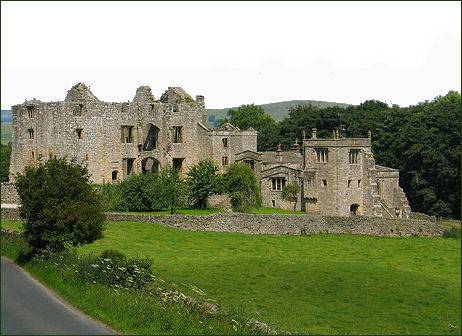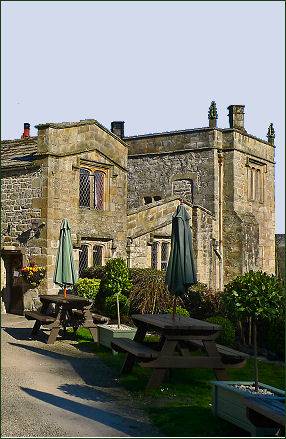Barden Tower
OS grid reference:- SE 050 571
 The imposing ruins of Barden Tower, a grade I listed building, stand between historic Bolton Abbey and the attractive village of Burnsall in Wharfedale, the Yorkshire Dales National Park.
The imposing ruins of Barden Tower, a grade I listed building, stand between historic Bolton Abbey and the attractive village of Burnsall in Wharfedale, the Yorkshire Dales National Park.
The name Barden means "the valley of the wild boar" in Old English or Anglo-Saxon. It was part of the Craven Estates which were granted to the Norman Robert de Romille following the Norman Conquest of 1066.
The Tower was originally one of several such hunting lodges in the once thickly forested area. It later was to become an administrative centre holding forest courts and capable of defending itself against marauding Scots. Along with several others in neighbouring valleys, the tower became part of the outlying defences for nearby Skipton Castle.
Barden and its surrounding lands came into the possession of the aristocratic Clifford family in 1310. Barden Tower itself was constructed in the late fifteenth century on the site of a former hunting lodge by Henry Clifford, 10th Baron de Clifford.
 The Cliffords held large estates in the north of England and were staunch supporters of the House of Lancaster during the dynastic conflict known as the Wars of the Roses. Henry Clifford's grandfather, Thomas Clifford, was killed at the first battle of St Albans in 1455 and his father, John Clifford, had in revenge for his father's death at the hands of Yorkists, slain Edmund Earl of Rutland, the seventeen year old second son of Richard Plantagenet, Duke of York, at the Battle of Wakefield in 1460, where the Duke of York was also killed. John Clifford was himself killed at Ferrybridge on 28 March 1461, on the eve of the decisive Yorkist victory of Towton, when he was struck by an arrow in the throat after having carelessly removed his gorget.
The Cliffords held large estates in the north of England and were staunch supporters of the House of Lancaster during the dynastic conflict known as the Wars of the Roses. Henry Clifford's grandfather, Thomas Clifford, was killed at the first battle of St Albans in 1455 and his father, John Clifford, had in revenge for his father's death at the hands of Yorkists, slain Edmund Earl of Rutland, the seventeen year old second son of Richard Plantagenet, Duke of York, at the Battle of Wakefield in 1460, where the Duke of York was also killed. John Clifford was himself killed at Ferrybridge on 28 March 1461, on the eve of the decisive Yorkist victory of Towton, when he was struck by an arrow in the throat after having carelessly removed his gorget.
His son, the then seven year old Henry Clifford, then at Skipton Castle, was sent into hiding by his mother, Lady Margaret, an attainder was then placed against Henry for his father's killing of Edmund, the brother of King Edward IV. His barony of Skipton was granted to Sir William Stanley, that of Westmoreland to Richard, Duke of Gloucester, the king's youngest brother. For his own protection the young Henry was sent to live in Londesborough on the property of a trusted family nurse where he tended sheep with the family, from which he became known as the 'Shepherd Lord'. Later, when his mother feared he would be discovered, she moved him to Threlkeld in Cumberland.
 When Henry Tudor defeated the Yorkist King Richard III at the Battle of Bosworth in 1485 the Lancastrian families, including the Cliffords, regained their estates and possessions. After nearly 25 years in hiding, Henry Clifford was appointed hereditary Sheriff of Westmorland.
When Henry Tudor defeated the Yorkist King Richard III at the Battle of Bosworth in 1485 the Lancastrian families, including the Cliffords, regained their estates and possessions. After nearly 25 years in hiding, Henry Clifford was appointed hereditary Sheriff of Westmorland.
Henry then decided to take up residence at Barden Tower in preference to his main seat of power in nearby Skipton Castle. He enlarged the Tower and built the chapel at the Priests House and, with the Canons of Bolton Priory, had a keen interest in astronomy which led to the upstairs dining room being named the "Stargazers Room". He became more of a recluse from the outside world although held regular feasts for the locals in the Great Hall.
In 1513, then in his sixtieth year, Henry Clifford led the men of the Craven district north into battle against the Scots at Flodden Field, when Upper Wharfedale and Langstrothdale echoed with the pomp and tramp of feudal warfare for the last time. The Scots were utterly defeated and their king, James IV was slain in the battle. It is believed that the pikes and halberds still hanging from the beams in the Priest's House dining area were used at Flodden Field. Halberds reputed to have been used at the battle were proudly passed down to descendants and, as late as the middle of the twentieth century, could still be found in some farmhouses in the area.
Barden Tower was captured by rebels during the Pilgrimage of Grace uprising against Henry VIII's religious policies in 1536. After the rebellion was suppressed, Barden was repaired but the heirs of Henry Clifford increasingly preferred other residences.
The heiress Lady Anne Clifford, daughter of George Clifford, 3rd Earl of Cumberland, came into possession of the Clifford estates in 1643 after a lenghthy legal battle. Initially the Civil Wars prevented much progress being made but by 1657 restoration work on the Tower had been undertaken. Following the death of Lady Anne Clifford in 1676, Barden Tower was inherited by the Earls of Cork, it is today owned by the Dukes of Devonshire. However the Tower has not been inhabited since the death of Lady Anne and fell into ruin through the eighteenth century.
The Priests House (pictured above left) was the private chapel of the Barden Tower. The roof is supported by large oak beams, while its walls, of immense thickness, date from the thirteenth century. The House forms with the Chapel a most unique piece of architecture with its huge fireplace, mullions and diamond-shaped panes. The main dining area in the House was actually the balcony to the Barden Chapel. However, times changed and so did the use of the building. For the last 75 years or so the Chapel has been unoccupied and gradually left to fall into decay.
Only the outer shell of the tower house remains of Barden Tower. Access to the inside is off limits to the public due to danger of falling rocks from the ruin. Works commenced in November 2015 to improve the basic fabric of the Priest's House and also renovate the Chapel to bring back into use as a brand new function venue. It will be completed by May 2016 and will be able to accommodate up to 80 for weddings, dining, music nights, plays and a facility for the local community.
Location
Barden Tower is situated off the B6160 road between Harrogate and Skipton.
